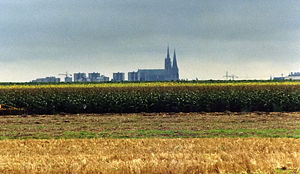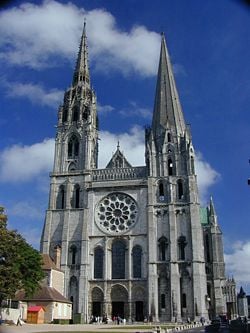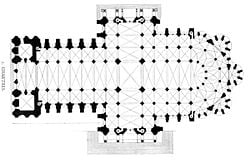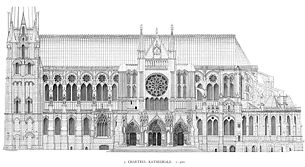Chartres Cathedral
| ||||||||||||||||||||||
|
File:Chartres Cathedral 000.JPG Chartres roofline and profile rises over the modern town. | ||||||||||||||||||||||
|
File:ChartresWestEndDB407.jpg West end of Chartres | ||||||||||||||||||||||
The Cathedral of Our Lady of Chartres, (French: Cathédrale Notre-Dame de Chartres), located in Chartres, about 50 km from Paris, is considered one of the finest examples in all France of the Gothic style of architecture.
Chartres is a cathedral that inspires superlatives, and there are few architectural historians who have not waxed lyrical about its soaring aisles and delicate carving. Begun in the twelfth century, the cathedral established several new architectural features (flying buttresses and the arches used) and pioneered new techniques for construction at high elevations above ground (such as the converting the war machines known as trebuchets into hoisting cranes).
During its early construction, the cathedral was burned down once, nearly consumed by fire a second time, and formed the focal point of several tax revolts and riots which were incited by a local countess and influential town burgers who opposed the increased influence of the church and especially the onerous taxes being used to finance it's construction. The cathedral is still the seat of the Diocese of Chartres, in the Roman Catholic ecclesiastical province of Tours.
The cathedral was the most important building in the town of Chartres. It was the center of the economy, the most famous landmark and the focal point of almost every activity that is provided by civic buildings in towns today. In the Middle Ages, the cathedral functioned sometimes as a marketplace, with the different portals of the basilica selling different items. Sometimes the clergy would try, in vain, to stop the life of the markets from entering into the cathedral. Workers of various professions gathered in the cathedral seeking jobs, such as carpenters and masons. Food was even allowed to be sold there.
In 1979, the cathedral became a designated UNESCO World Heritage site. Its Heritage description reads: "Partly built starting in 1145, and then reconstructed over a 26-year period after the fire of 1194, Chartres Cathedral marks the high point of French Gothic art. The vast nave, in pure ogival style, the porches adorned with fine sculptures from the middle of the twelfth century, and the magnificent twelfth- and thirteenth-century, stained-glass windows, all in remarkable condition, combine to make it a masterpiece."
History of the cathedral
According to legend, since 876 the Cathedral's site has housed a tunic that has been said to have belonged to the Blessed Virgin Mary, the Sancta Camisia. The relic had supposedly been given to the Cathedral by Charlemagne who received it as a gift during a crusade in Jerusalem. In fact, the relic was a gift from Charles the Bald and it has been asserted that the fabric came from Syria and that it had been woven during the first century AD. For hundreds of years, Chartres has been a very important Marian pilgrimage center and today the faithful still come from the world over to honor the relic. As a consequence, several cathedrals have occupied the site, which fell to that all too common middle-ages scourge of wooden construction, with periodic uncontrolled fire sweeping through towns without fire-fighting equipment or chimney's in an age reliant on burning wood for heating and cooking.
The church was an especially popular pilgrimage destination in the twelfth century. There were four great fairs which coincided with the main feast days of the Virgin; the Purification; the Annunciation; the Assumption; and the Nativity. The fairs were held in the surrounding area of the cathedral were attended by many of the pilgrims in town for the feast days and to see the cloak of the Virgin.
Even before the Gothic cathedral was built, Chartres had been a place of pilgrimage. When ergotism (more popularly known in the Middle Ages as "St. Anthony's fire") afflicted many victims, the crypt of the original church became a hospital to care for the sick.
The existing cathedral at Chartres is another of the French Gothic masterpieces built because fire had destroyed its predecessors. After the first cathedral of any great substance burnt down in 1020 (prior to this, other churches on the site had disappeared in smoke), a glorious new Romanesque basilica, which included a massive crypt, was built under the direction of Bishop Fulbert and later under the direction of Geoffroy de Lèves. However, having survived a fire in 1134 which destroyed much of the rest of the town, disaster struck yet again in the night from June 10 to 11, 1194, when lightning created a blaze that left only the west towers, the façade between them, and the crypt.
The people despaired when they believed that their sacred relic, the Sancta Camisia, had perished, too. But three days later, it was found unharmed in the treasury along with the priests who had taken it there for safety when the fire broke out and locked themselves in behind the iron trapdoors. The visiting Cardinal Melior of Pisa, a papal legate, told the people that the survival of the relic was a sign from Mary herself and that another, even more magnificent, cathedral should be built in Chartres.
Construction of a new building on the Romanesque foundations of the earlier church (destroyed by fire in 1134) was begun in 1145 in a blaze of enthusiasm dubbed the 'Cult of the Carts.' During this religious outburst a crowd of more than 1,000 penitents dragged carts filled with building provisions including stones, wood, grain, etc. to the site. In 1194, a fire destroyed all but the west front of the cathedral (and much of the town), so that part is in the "early Gothic" style. The body of the cathedral was rebuilt between 1194 and 1220, a remarkably short span for medieval cathedrals. It has a ground area of 117,058 square feet.
Rebuilding, with the help of donations from all over France, began almost immediately, using the plans laid out by the first architect, still anonymous, in order to preserve the harmonious aspect of the Cathedral. The enthusiasm for the project was such that the people of the city voluntarily gathered to haul the stone needed from local quarries 5 miles away.
Work began first on the nave and by 1220 the main structure was complete, with the old crypt, along with the mid-twelfth-century Royal Portal which had also escaped the fire, incorporated into the new building. On October 24, 1260, the cathedral was finally dedicated in the presence of King Louis IX. However, the cathedral was never completed with the full set of spires that appear to have been planned for it in the early thirteenth century.
Description
Chartres is a cathedral that inspires superlatives, and there are few architectural historians who have not waxed lyrical about its soaring aisles and delicate carving. These tributes are richly deserved, for Chartres is truly one of the greatest of all French Gothic cathedrals. From a distance it seems to hover in mid-air above waving fields of wheat, and it is only when the visitor draws closer that the city comes into view, clustering around the hill on which the cathedral stands. Its two contrasting spires — one, a 105 metre (349 ft) plain pyramid dating from the 1140s, and the other a 113 metre (377 ft) tall early 16th century Flamboyant spire on top of an older tower — soar upwards over the pale green roof, while all around the outside are complex flying buttresses.
The plan is cruciform, with a 28 m long nave, and short transepts to the south and north. The east end is rounded with an ambulatory which has five semi-circular chapels radiating from it. The cathedral extensively used flying buttresses in its original plan, and these supported the weight of the extremely high vaults, at the time of being built, the highest in France. The new High Gothic cathedral at Chartres used 4 rib vaults in a rectangular space, instead of 6 in a square pattern, as in earlier Gothic cathedrals such as at Laon. The skeletal system of supports, from the compound piers all the way up to the springing and transverse and diagonal ribs, allowed large spaces of the cathedral to be free for stained glass work, as well as a towering height.
The spacious nave stands 36 m high, and there is an unbroken view from the western end right along to the magnificent dome of the apse in the east. Clustered columns rise dramatically from plain bases to the high pointed arches of the ceiling, directing the eye to the massive clerestory windows in the apse.
Everywhere vivid colour splashes on to the floor from the superb stained glass windows. Dating from the early 13th century, the glass largely escaped harm during the religious wars of the 16th century; it is said to constitute one of the most complete collections of medieval stained glass in the world, despite "modernization" in 1753 when some of it was removed by well-intentioned but misguided clergy. From the original 186 stained-glass windows, 152 have survived. The stained glass windows are particularly renowned for their vivid blue color, especially in a representation of the Madonna and Child known as the Blue Virgin Window.
The windows also present the first European wheelbarrow.[1] Also, on the exterior of Chartres Cathedral, by the north door, there is a carving on a pillar, which alludes to an object sought by the Knights Templars when, in 1118, they undertook excavations beneath the Temple of Solomon in Jerusalem and made an important secret discovery. An ancient tradition maintains that the Ark of the Covenant had been secreted deep beneath Solomon's Temple centuries before the fall of the city to the Romans. Hugh de Payen, one of the original nine Templar Knights, was chosen by Pope Urban II to lead an expedition to locate the Ark and bring it to Europe. Persistent legends recount that Hugh de Payen, having found the ark, deposited it for safekeeping in the crypt of Chartres Cathedral, where it remained for centuries. The carving on the pillar at Chartres is supposed to represent the Ark of the Covenant being transported on some type of wheeled vehicle, a cart or, possibly, a wheelbarrow.
During the second World War, most of the stained glass was removed from the cathedral, and stored in the surrounding countryside, for protection from German bombers. At the close of the war, the windows were taken out of hiding and replaced.
Several of the windows were donated by royalty, such as the rose window at the north transept, which was a gift from the French queen Blanche of Castile. The royal influence is shown in some of the long rectangular lancet windows which display the royal symbols of the yellow fleurs-de-lis on a blue background and also yellow castles on a red background.Windows were also donated from lords, locals and tradespeople.
The cathedral has three large rose windows: one on the west front with a theme of The Last Judgment; one on the north transept with a theme of the Glorification of the Virgin; and one on the south transept with a theme of the Glorification of Christ.
On the doors and porches medieval carvings of statues holding swords, crosses, books and trade tools parade around the portals, their expressions as clear today as when first carved 700 years ago. The sculptures on the west façade depict Christ's ascension into heaven, episodes from his life, saints, apostles, Christ in the lap of Mary and other religious scenes. Below the religious figures are statues of kings and queens, which is the reason why this entrance is known as the 'royal' portal. While these figures are based on figures from the Old Testament, they were also regarded as images of current kings and queens when they were constructed. The symbolism of showing royalty displayed slightly lower than the religious sculptures, but still very close, implies the relationship between the kings and God. It is a way of displaying the authority of royalty, showing them so close to figures of Christ, it gives the impression they have been ordained and put in place by God. Sculptures of the Seven Liberal Arts appeared in the archivolt of the right bay of the Royal Portal, which represented the school at Chartres.
The Cathedral of Chartres was not destroyed nor looted during the French Revolution and the numerous restorations have not altered its glorious beauty. It always stayed the same: a triumph of Gothic art. The cathedral was added to UNESCO's list of World Heritage Sites in 1979.
In the Middle Ages the cathedral also functioned as an important cathedral school. Charlemagne wanted a system of education for the French people in the ninth century, and since it was difficult and costly for new schools to be built, it was easier to use already existing infrastructure. So he ordered that both cathedrals and monasteries maintain schools. Cathedral schools eventually took over from monastic schools as the main places of education. In the 11th century the education system was controlled by the clergy in cathedrals such as Chartres. The cathedral itself symbolized the school. Many French cathedral schools had specialties, and Chartres was most renowned for the study of logic. The new logic taught in Chartres was regarded by many as being even ahead of Paris. One person who was educated at Chartres was John of Salisbury, an English philosopher and writer, who had his classical training there.
Statistics
- length: 130 m
- width: 32/46 m
- nave: height 37 meters; width 16.4 m
- 176 stained-glass windows
- rood screen: 200 statues in 41 scenes
The cathedral was damaged in the Revolution when a mob began to destroy the sculpture on the north porch. This is one of the few occasions on which the anti-religious fervour was stopped by the townfolk. The Revolutionary Committee decided to blow the building up and asked a local master mason (architect) to organise it. He saved the building by pointing out that the vast amount of rubble from the demolished building would so clog the streets it would take years to clear away. However, when metal was needed for the army the brass plaque in the centre of the labyrinth was removed and melted down - our only record of what was on the plaque was Felibien's description.
Notes
Stranger in the Village Baldwin, James
- ↑ "Engines of Our Ingenuity" n°377, by John H. Lienhard]
Italic text
Commune of Chartres Distant view of Chartres | |
| Location | |
| Longitude | 01° 29' 21" E |
| Latitude | 48° 26' 50" N |
| Administration | |
|---|---|
| Country | |
| Region | Centre |
| Department | Eure-et-Loir (préfecture) |
| Arrondissement | Chartres |
| Canton | Chief town of 3 cantons |
| Intercommunality | Chartres Métropole |
| Mayor | Jean-Pierre Gorges (UMP) (2001-2008) |
| Statistics | |
| Altitude | 121 m–161 m (avg. 142 m) |
| Land area¹ | 16.85 km² |
| Population² (1999) |
40,361 |
| - Density (1999) | 2,395/km² |
| Miscellaneous | |
| INSEE/Postal code | 28085/ 28000 |
| ¹ French Land Register data, which excludes lakes, ponds, glaciers > 1 km² (0.386 sq mi or 247 acres) and river estuaries. | |
| ² Population sans doubles comptes: single count of residents of multiple communes (e.g. students and military personnel). | |
Town of Chartres
Geography
Chartres is built on the left bank of the Eure River, on a hill crowned by its famous cathedral, the spires of which are a landmark in the surrounding country. To the south-east stretches the fruitful plain of Beauce, the "granary of France," of which the town is the commercial centre.
History
Chartres was one of the principal towns of the Carnutes, and by the Romans was called Autricum, from the river Autura (Eure), and afterwards civitas Carnutum. The name "Chartres" derives from "Carnutes." It was burnt by the Normans in 858, and unsuccessfully besieged by them in 911.
During the Middle Ages it was the chief town of Beauce, and gave its name to a countship which was held by the counts of Blois and Champagne and afterwards by the house of Chatillon, a member of which in 1286 sold it to the crown. It was raised to the rank of a duchy in 1528 by Francis I. After the time of Louis XIV the title of duke of Chartres was hereditary in the family of Orleans.
In 1417 it fell into the hands of the English, from whom it was recovered in 1432. It became seat of a Duchy in 1528. During the Wars of Religion, it was attacked unsuccessfully by the Protestants in 1568, and was taken in 1591 by Henry IV, who was crowned there three years afterwards.
In the Franco-Prussian War it was seized by the Germans on October 2 1870, and continued during the rest of the Campaign an important centre of operations.
The city suffered heavy damage by bombing in the course of World War II.
Other sights
The abbey church of St Pierre[1], dating chiefly from the 13th century, contains, besides some fine stained glass, twelve representations of the apostles in enamel, executed about 1547 by Léonard Limosin. Of the other churches of Chartres also noteworthy are St Aignan (13th, 16th and 17th centuries) and St Martin-au-Val (12th century).
The surrounding city financed the stained glass windows.
Museums:
- Musée des Beaux-Arts, fine arts museum (located near the Cathedral of Chartres) housed in the former Episcopal palace.
- Le Grenier de l'Histoire Musée, history museum specializing in military uniforms and accoutrements.
- Le Centre International du Vitrail, a workshop-museum and cultural center devoted to stained glass art.
- Muséum de sciences naturelles et de la préhistoire, Natural Science and Prehistory Museum
- Conservatoire du Machinisme et des Pratiques Agricoles, an agricultural museum
The Eure River, which at this point divides into three branches, is crossed by several bridges, some of them ancient, and is fringed in places by remains of the old fortifications, of which the Porte Guillaume (14th century), a gateway flanked by towers, is the most complete specimen. The steep, narrow streets of the old town contrast with the wide, shady boulevards which encircle it and divide it from the suburbs. The Cbs St Jean, a pleasant park, lies to the north-west, and squares and open spaces are numerous.
The hotel de ville, a building of the 17th century, containing a museum and library, an older hotel de ville of the 13th century, and several medieval and Renaissance houses, are of interest. There is a statue of General F. S. Marceau-Desgraviers (b. 1769), a native of the town.
Economy
Chartres is one of the most important market town in the region of Beauce (known as "the granary of France").
The game-pies and other delicacies of Chartres are well known, and the industries also include flour-milling, brewing, distilling, iron-founding, leather manufacture, perfumes, dyeing, and the manufacture of electronic equipments, car accessories, stained glass, billiard requisites and hosiery.
Diocese
The town is the seat of a bishop, a prefecture, a court of assizes, and has tribunals of first instance and of commerce, a chamber of commerce, training colleges, a high school for boys, a communal college for girls, and a branch of the Bank of France.
Pilgrimages
Chartres has been a site of Christian pilgrimage since the Middle Ages. The poet Charles Péguy (1873-1914) revived the pilgrimage route between Paris and Chartres before the First World War. After the war, some students carried on the pilgrimage in his memory. Since the 1980s, the association Notre-Dame de Chrétienté (http://www.nd-chretiente.com), with offices in Versailles, has organized the annual 100-km pilgrimage on foot from the cathedral of Notre-Dame de Paris to the cathedral of Notre-Dame de Chartres. About 15,000 pilgrims, mostly young families from all over France, participate every year.
Gallery of Images
- France Eure et Loir Chartres Cathedrale nuit 02.jpg
The Cathedral of Notre Dame
- France Eure et Loir Chartres Cathedrale nuit 03.jpg
The Cathedral of Notre Dame
- France Eure-et-Loir Chartres Cathedrale 02.jpg
The Cathedral of Notre Dame
- France Eure et Loir Chartres Maison a colombage.jpg
Half-timbered house in the Old Town
- France Eure et Loir Chartres Vieille ville.jpg
Hill of St. François
- France Eure et Loir Chartres Vieille ville 02.jpg
View south from the Cathedral
ReferencesISBN links support NWE through referral fees
- Favier, Jean. The World of Chartres, Henry N. Abrams, 1990. ISBN 0-8109-1796-3
- James, John. The Master Masons of Chartres, West Grinstead, 1990, ISBN 0646008056
- James, John. The Contractors of Chartres, Wyong, ii vols. 1979-1981, ISBN 0959600523
- Markale, Jean. Cathedral of the Black Madonna: The Druids and the Mysteries of Chartres, Inner Traditions, 2004. ISBN 978-1594770204
- Miller, Malcolm. Chartres Cathedral, Riverside Book Company, 1997. ISBN 978-1878351548
- Strachan, Gordon, & Perceval, Oliver. Chartres: Sacred Geometry, Sacred Space, Floris Books, 2003. ISBN 978-0863153912
External links
Credit
Credits
New World Encyclopedia writers and editors rewrote and completed the Wikipedia article in accordance with New World Encyclopedia standards. This article abides by terms of the Creative Commons CC-by-sa 3.0 License (CC-by-sa), which may be used and disseminated with proper attribution. Credit is due under the terms of this license that can reference both the New World Encyclopedia contributors and the selfless volunteer contributors of the Wikimedia Foundation. To cite this article click here for a list of acceptable citing formats.The history of earlier contributions by wikipedians is accessible to researchers here:
The history of this article since it was imported to New World Encyclopedia:
Note: Some restrictions may apply to use of individual images which are separately licensed.





